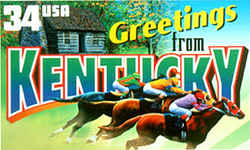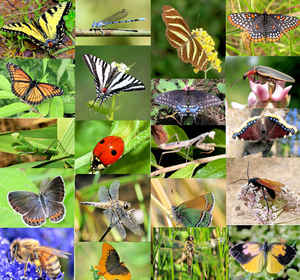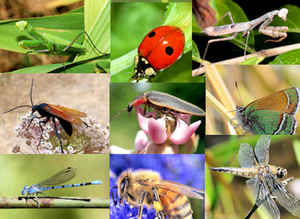
Kentucky Symbols
Kentucky State Agricultural Insect
Honeybee

(Apis mellifera)
Adopted on July 15, 2010.
The honey bee, (apis mellifera,) was designated the official state agricultural insect of Kentucky in 2010. Laurel beekeeper helps establish the designation in House Bill 175. (Kentucky also recognizes a state butterfly). The honeybee is recognized as an official state symbol in the below mentioned states (see State Insects), primarily because honeybees play such an important role in agriculture. The new designation, which was passed in House Bill 175 by the General Assembly this year, is the result of a light bulb moment on behalf of local beekeeper Bruce Bailey.
Did you know that: The honey bee has been proclaimed the official state insect in each of the following states:
Arkansas | Georgia | Kansas
| Kentucky | Louisiana
Maine | Mississippi |
Missouri | Nebraska | New Jersey
North Carolina | Oklahoma | South
Dakota | Tennessee
Utah | Vermont | West Virginia
| Wisconsin
Kentucky State Agricultural Insect: Honeybee

What's in a Name?
Where Does the Honeybee get her Name?
The honeybee's Latin name, Apis melifera L., stands for "Honey Maker".
The honeybee plays a vital economic role in Kentucky through its pollination of various crops, trees, and grasses. The honeybee is the only insect that can be moved for the express purpose of pollination.
Bees produce honey as food stores for the hive during the long months of winter when flowers aren't blooming and therefore little or no nectar is available to them. European honey bees, genus Apis Mellifera, produce such an abundance of honey, far more than the hive can eat, that humans can harvest the excess. For this reason, European honey bees can be found in beekeeper's hives around the world!
The taste, color and nutrient content of honey varies from place to place depending upon the kind of flora growing in the area. For example, Tupelo honey (from Kentucky) is twice as sweet as most honey. Many people take honey from their own neighborhood as a kind of natural antihistamine.
August 24, 2010
Bee named official Ky. agricultural insect
Laurel beekeeper helps establish the designation in House Bill 175
By Tara Kaprowy Staff Writer
LAUREL COUNTY, Ky. - The honey bee has been named the official agricultural insect of Kentucky, a fact that was duly celebrated at the Southeastern
Kentucky Beekeepers Association Thursday.
The new designation, which was passed in House Bill 175 by the General Assembly this year, is the result of a light bulb moment on behalf of local
beekeeper Bruce Bailey.
"I was on the computer through the winter and I got to looking at other state sites,"he said.
Bailey noticed many states in the country have the honey bee as their official state insect. Bailey discovered Kentucky's official insect was already
the monarch butterfly, but the agricultural insect designation had not yet been determined.
Bailey decided it should be the honey bee, and contacted the Laurel County Extension Service to get in touch with the right people. They, in turn,
contacted state Rep. Jim Stewart, R-Flatlick, who got in touch with Dr. Tammy Horn.
With her help, the honey bee designation was tacked onto the bill, whose content focuses on using reclaimed coal mining sites as habitat sites for
bees; Horn did research on the subject.
At the beekeepers meeting Thursday, state Sen. Tom Jensen, R-London, spoke to the crowd of about 40 how the bill became law.
For his part, Bailey was happy with the new designation.
"The bees are in trouble and we were trying to get something to make people aware,"he said.
The Southeastern Kentucky Beekeepers Association meets at 6:30 p.m. the third Thursday of the month at the Laurel County Extension Service from March
to October.
Characteristics of the Honeybee
Sources of Nectar
Honey bees forage on many plants for nectar or pollen. All of these sources provide food for the colony. The number of plants that produce large
quantities of surplus nectar for a honey crop are quite limited. Most of the honey produced in the United States is made from nectar that was collected
from about 100 plant species.
In Kentucky, the clovers are the number one source of nectar. White dutch, crimson, white sweet and yellow sweet clovers are some of the surplus nectar
sources. Alfalfa and vetch are related leguminous honey plants.
The tulip-poplar tree is the second largest supplier of nectar for honey production (the bees collect large quantities of nectar from this tree which
blooms in early May).
Sourwood honey is the most popular honey in Kentucky. A large surplus of sourwood honey is produced once every five to seven years in the higher elevations.
In most years, bees store one to two supers of sourwood honey per colony.
Honeybees probably originated in Tropical Africa and spread from South Africa to Northern Europe and East into India and China. They were brought to the Americas with the first colonists and are now distributed world-wide. The first bees appear in the fossil record in deposits dating about 40 million years ago in the Eocene. At about 30 million years before present they appear to have developed social behavior and structurally are virtually identical with modern bees.
Colony:
Honey bees are social insects, with a marked division of labor between the various types of bees in the colony. A colony of honey bees includes a queen, drones and workers.
The Queen:
The queen is the only sexually developed female in the hive. She is the largest bee in the colony.
A two-day-old larva is selected by the workers to be reared as the queen. She will emerge from her cell 11 days later to mate in flight with approximately
18 drone (male) bees. During this mating, she receives several million sperm cells, which last her entire life span of nearly two years.
The queen starts to lay eggs about 10 days after mating. A productive queen can lay 3,000 eggs in a single day.
The Drones:
Drones are stout male bees that have no stingers. Drones do not collect food or pollen from flowers. Their sole purpose is to mate with the queen. If the colony is short on food, drones are often kicked out of the hive.
The Workers:
Workers, the smallest bees in the colony, are sexually undeveloped females. A colony can have 50,000 to 60,000 workers.
The life span of a worker bee varies according to the time of year. Her life expectancy is approximately 28 to 35 days. Workers that are reared in
September and October, however, can live through the winter.
Workers feed the queen and larvae, guard the hive entrance and help to keep the hive cool by fanning their wings. Worker bees also collect nectar to
make honey. In addition, honey bees produce wax comb. The comb is composed of hexagonal cells which have walls that are only 2/1000 inch thick, but
support 25 times their own weight.
Honey bees' wings stroke 11,400 times per minute, thus making their distinctive buzz.
Kentucky Law
The law designating the honeybee as the official Kentucky state insect is found in the Kentucky Revised Statutes, Title 1, Chapter 2, Section 2.081.
TITLE I - SOVEREIGNTY AND JURISDICTION OF THE COMMONWEALTH.
CHAPTER 2 - CITIZENSHIP, EMBLEMS, HOLIDAYS, AND TIME.
2.081 State agricultural insect.
The honeybee is named and designated as the official state agricultural insect of Kentucky.
Effective:July 15, 2010
History: Created 2010 Ky. Acts ch. 19, sec 2, effective July 15, 2010.
Taxonomic Hierarchy: Western Honey Bee
Kingdom: Animalia (Animals)
Phylum: Arthropoda (Arthropods)
Subphylum: Hexapoda (Hexapods)
Class: Insecta (Insects)
Order: Hymenoptera (Ants, Bees, Wasps and Sawflies)
No Taxon: (Aculeata - Ants, Bees and Stinging Wasps)
No Taxon: (Anthophila (Apoidea) - Bees)
Family: Apidae (Cuckoo, Carpenter, Digger, Bumble, and Honey Bees)
Subfamily: Apinae (Honey, Bumble, Long-horned, Orchid, and Digger Bees)
Tribe: Apini (Honey Bees)
Genus; Apis
Species: mellifera (Western Honey Bee)
Butterflies, and Bugs







